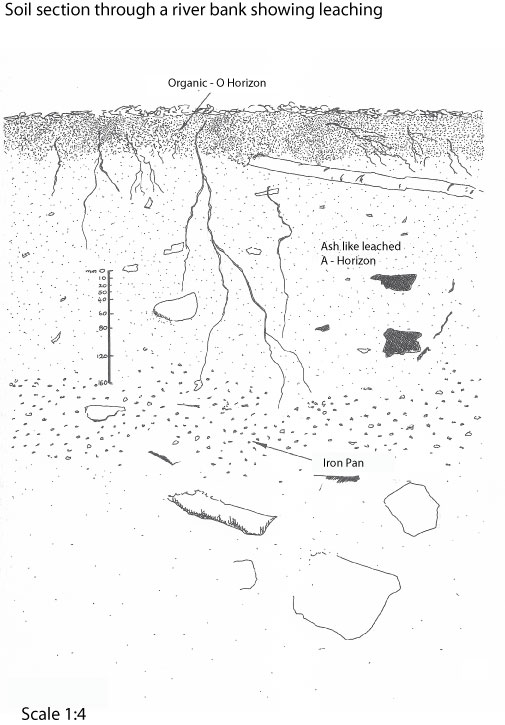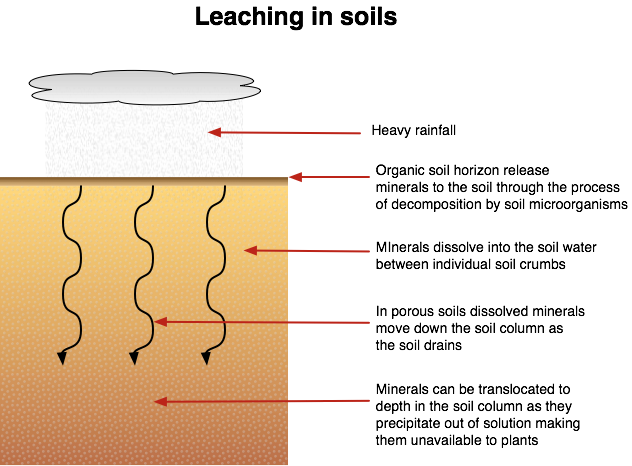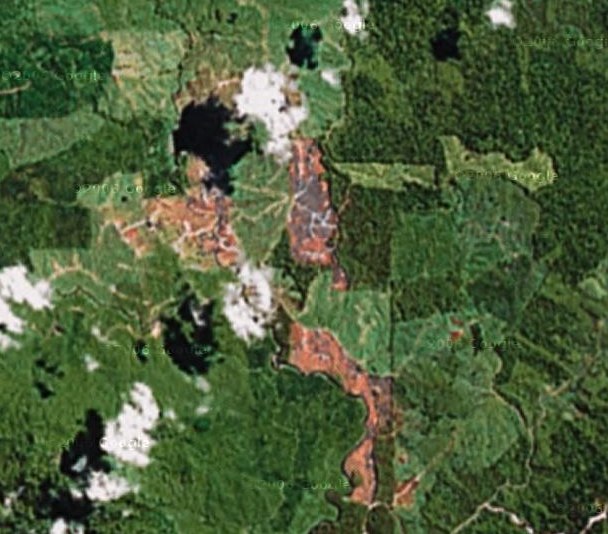3.4. 2: Soil Structure
SOIL TEXTURE
The mineral portion of soil can be divided up into three particles based on size: sand, silt and clay.
Particle diameter Particle
0.05mm - 2mm Sand
0.002mm - 0.05mm Silt
Less than 0.002mm Clay
The proportion of each of these particles gives soil its texture. Most soils also contain particles that are larger than 2mm in diameter (pebbles and stones), but these are not considered in a description of soil texture.
It is possible to feel the texture of moist soil if you rub it between your fingers. Sandy soils are gritty and fall apart easily. Silty soils feel slippery like wet talcum powder and hold together better than sand soils. Clay soils feel sticky and can be rolled up into a ball easily. Most soils contain a mixture of different soil particles and can be described as sandy clay or silty clays. If a fairly equal portion of each size is present then the soil is said to be a loam. Loam soils are fairly fertile, drain well and can be worked easily making it the preferred soil for agricultural use.
It is possible to get a clearer picture of the soil proportions of soil particles by drying out a soil sample and passing to through a series of sieves of decreasing mess size. First 2mm, then 0.05mm and finally 0.002mm separating the soil into its portion of clay, silt, sand and stones. The ratio of the weight of these is then compared to a soil triangle to find the soil class.
POROSITY AND PERMEABILITY
Related to a soils texture is the amount of space between particles (porosity) and the ease at which gases and liquids can pass through the soil (permeability). Soils with a very fine clay particle texture have lots of micropores. This results in a combined large pore space made up of many microscopic pores but a low permeability as water molecules easily fill these spaces and become adhered to the clay surface trapping the water as a film around the clay particles. In contrast sandy soils have fewer macropores with a smaller total space. These spaces are to large for waters adhesive properties to work so sandy soils drain well.
The low permeability of clay means that it can also lock dissolved minerals between the pores making it hard for plant roots to access. Strangely the result can be a soil that is rich in minerals but has low fertility.
SOIL STRUCTURE
In the majority of soils the particles do not exist as individual grains but are packed together in clumps or peds. The individual peds can be distinguished as a variety of shapes. Crumbs are small and spherical, larger peds are more angular and these can be blocky or if elongated are said to be prismatic and final platy or flat.
The soil structure is a result of both the texture and the processes that have formed the soil such as root action. The structure has an effect on the stability of soil, with larger and more angular peds having higher stability that soils made up of small crumbs. The structure of the soil also has an effect on the amount of air and water in the soil. Crumb soils contain large portions of sand and platy soils are high in clay.
Both the chemical and physical characteristics of a soil are mainly controlled by clay and humus. Both of these soil constituents are the places where chemical reactions and nutrient exchange occurs. Clay and humus attract mineral ions to their surface, helping slow their loss through leaching and in turn making them available to plant. The large surfaces of clay and humus are charged and this is what allows mineral ions and water to stick to their surface.
While humus has the greater water holding capacity, the fact that clay is found in much greater amounts makes it more important for the exchange of chemical in the soil. Clay particles have a negative surface charge this means that positively charged ions, potassium (K+), calcium (Ca2+), magnesium (Mg2+) and ammonium (NH4+) are attracted and bind to the surface of clay particles. This helps to prevent these minerals being easily leached from the soil. Negatively charged ions like chlorides (Cl-), Sulphates (SO42-) and nitrates (NO3-) which do not get attracted are lost much more easily by leaching.
 Soil chemistry though is not just a matter of the amount of clay in the soil. The acidity of the soil has a great affect on the chemical characteristics. As the soil absorbs more water clay particles begin to fill up with positive hydrogen ions (H+). This not only binds soil water tightly to clay it also make the soil more acidic. It also reduces the amount of other positive ions that can bind allowing potassium, magnesium and ammonium to be lost through leaching. Along with the loss of these important nutrients, as soil pH decreases ions of Aluminium and Iron start to become more available to plants. Both of these are plant toxins.
Soil chemistry though is not just a matter of the amount of clay in the soil. The acidity of the soil has a great affect on the chemical characteristics. As the soil absorbs more water clay particles begin to fill up with positive hydrogen ions (H+). This not only binds soil water tightly to clay it also make the soil more acidic. It also reduces the amount of other positive ions that can bind allowing potassium, magnesium and ammonium to be lost through leaching. Along with the loss of these important nutrients, as soil pH decreases ions of Aluminium and Iron start to become more available to plants. Both of these are plant toxins.
Acidification of soils has had a major impact on Forestry in Northern Europe where acid rain caused by industrial pollution has made the soil more acid. This in turn has meant more available aluminum and iron ions in the soil causing damage to evergreen forestry through needle death.
IMPROVING THE SOIL
Adding lime.
Water is not the only factor that affects soil acidity, some soil processes themselves also make the soil more acidic. The breakdown of organic matter releases carbon dioxide through respiration. This then dissolves into the soil water creating carbonic acid. Nitrification of ammonium to nitrates increases acidity and the removal of basic ions through leaching all add to soil acidity. This in turn reduces soil fertility. For many centuries farmers have added lime, calcium carbonate, to counter soil acidification. Limestone or chalk that has been crushed is scattered on the soil. This helps to increase pH and so counter acidity. Lime also helps clay particles to stick together so that they act more like sand particles. The larger particles created are more free draining than raw clay and they trap more air, helping to improve decomposition by soil micro-organisms.
Plowing.
Plowing helps to break up the soil structure and increases drainage. In Northern countries plowing occurs in autumn so that frost can attack the clods of earth and break them further. Plowing also helps to mix humus through the top layers of the soil.
SOIL EROSION.
If natural vegetation covers a soil, processes that could damage the soil structure are largely eliminated. Leaves deflect heavy rain, roots hold the soil together and humus absorbs large quantities of water. If this natural cover is removed or even when it is replaced by agricultural vegetation soils can become prone to erosion.
Three major processes of soil erosion exist:
1. Sheet wash: large areas of surface soil are washed away during heavy storm periods and in mountainous areas moving as landslides.
2. Gullying: channels develop following rainfall. Over time these channels become much deeper.
3. Wind erosion: on dryer soils high winds continually remove the surface layer.
Each of these processes can be triggered by a number of causes.
Overgrazing of grasslands leaves bare patches where roots no longer hold the soil together. When this is combined with the action of rain and wind the bare patches become bigger and soil starts to be removed from the area.
Overcropping depletes soil nutrients. This reduces soil fertility as no nutrients are being returned to the soil. If the crop fails then the soil surface again becomes susceptible to erosion. This is especially true in dry regions where crop failure can lead to removal of topsoil be wind. During the 1930’s the American Mid West suffered a major period of wind erosion known as the “Dust bowlâ€. Through over use of the land an area about twice the size of the United Kingdom, from Nebraska through to Texas was affected by severe wind erosion. The winds moved soil and dust many thousands of kilometers.
Deforestation can have a massive effect on soil erosion, especially in tropical regions. The leave sof forest trees both deflect and slow down the progress of rain drops. This helps to stop them explosively removing soil particles. The root systems of forests help to bind the soil together and give it stability, while also absorbing large quantities of water from the soil directly. The absorbed water is eventually returned to the atmosphere via transpiration.
The Danum Valley area of East Malaysia and is an area of lowland tropical forest. Annual rainfall is over 2500mm yr-1 with little seasonality in the rain pattern This means that forestry operation occur throughout the year. Large parts of the forest are only selectively felled (only certain trees are taken out of the forest rather than just cutting down the entire forest area) but even where this occurs there is an increase in stream flow compared to areas with full canopy cover. This is because of the loss of transpiration returning water back to the atmosphere. Though this increase is much less than in clear felled areas.
Because of impermeable geology in the Danum catchment water tends to flow in the top surfaces of the soil rather than percolating down into bedrock. This means that heavy rainfall can create large flash floods. This makes the soils more sensitive to disturbance, especially from the large vehicles used by foresters.
The Danum catchment is covered by a network of channels, most of which continually flow with water. This makes it very difficult for forestry vehicles to cross the terrain without damaging the banks of stream channels and adding to soil erosion. Also where forestry companies have tried to drain areas, a or keep logging roads clear of water, some of these drainage channels have developed into wide gullies that carry eroded soil into the river systems.
Another major factor affecting soil erosion in Danum are the logging roads that have been put in place. Many of these have been built at very steep angles up slopes. The result of this is often mass movement of soil in large landslides. These eroded soils end up in the local streams and rivers and are lost from the forest.
Preventing soil erosion
Terracing.
In many mountainous countries soil can be easily washed away. Creating a series of terraces can prevent this. The soil is kept in place behind a series of low walls that creates row upon row of small steps up a slope with flat areas between each. Terracing is common in areas of Italy, Indian, China and South America.
Windbreaks and Shelter Belts
Planting trees and hedges or building stonewalls around fields all help to prevent soil being lost by wind blow. All act as windbreaks reducing the intensity of the wind. A secondary benefit is that any soil that is removed from the surface builds up around windbreaks themselves so is not totally lost.
Contour plowing
This is one of the earliest methods for prevent soil erosion on agricultural land. Furrows are plowed in rings around a slope rather than up and down it. This prevents soil being carried down hill by rain and surface flow of water.


